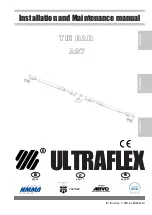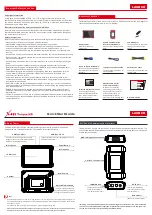
Calibration
In the calibration procedure, the patient is asked to switch their gaze
between the two dots that appear when the lasers are on. If the
patient cannot be calibrated, click
Default
to use the calibration
default values.
Caution:
During this procedure both lasers will turn on.
Do not look directly at the lasers.
1. Click
Run
2. Ask the patient to face the fixation dot and hold their head still.
3. Ask the patient to look right at the laser beam dot.
The calibration values are automatically saved.
Caution:
Once calibration has been performed, it is recommended
not to move the goggles.
Calibration Check
1. Ask the patient to stare at the fixation dot and move the head
side to side through a small angle (about 10 degrees).
2. Check that the eye and lateral head trace overlay.
3. If the eye and lateral head trace do not overlay, you need to
recalibrate or review the patient’s history.
4. Once the calibration has been checked and you are satisfied with
the result, click
Accept
.
The Collection window opens and you are ready to begin testing.
Head Position Feedback
Clinically, for dynamic positional testing and for repositioning
treatment, positioning the head properly is essential to acquiring
the proper diagnosis and successful treatment. Data from the head
sensor in the goggles tracks head movement. The head movement
seen in the software corresponds directly to the patient’s head
movement. This assists the tester to position the head in the various
positions unique for each dynamic positional test or repositioning
maneuver.
• The semicircular canal(s) being tested or treated is highlighted in
green.
• As the test or maneuver is performed, the blue dot moves with
the head.
• According to the test or treatment maneuver being performed,
each position is numbered and represented by a blue line. Move
the patient’s head aligning the blue dot with each successive
numbered blue line.
Positional Data Collection
1. Perform the dynamic positional test or a repositioning maneuver.
2. Ask the patient to keep their eyes wide open and perform the
test or treatment as described in the Dynamic Positional or
Repositioning Training video.
3. Click the Start button in the software or use a presentation
remote to start/stop the test and center the head for the head
position feedback.
A separately purchased presentation remote can be used with the
Otosuite
®
Vestibular application. An external monitor displays the
eye video, real time SPV, and elapsed time separately from the laptop
making viewing patient response from multiple positions in the room
possible.
Consult the Reference Manual in the software for more information.
©2021 Natus Medical Incorporated. All Rights Reserved. All product names appearing on this document
are trademarks or registered trademarks owned, licensed to, promoted or distributed by Natus Medical
Incorporated, its subsidiaries or affiliates. 06/2021. 7-50-1133-EN Rev04.
7-50-11303-EN
Healthcare solutions with one thing in mind. You.
natus.com
Natus Medical Incorporated
Positional
Quick Guide
ICS
®
Impulse



















